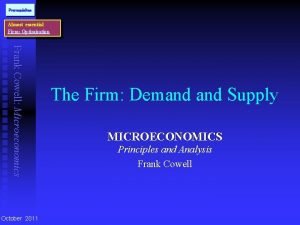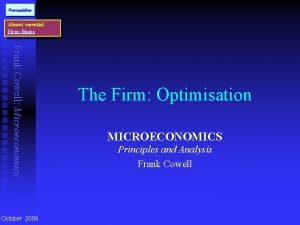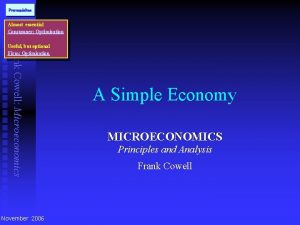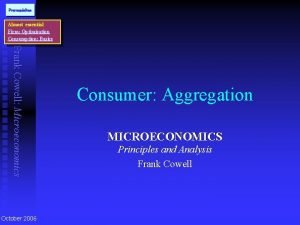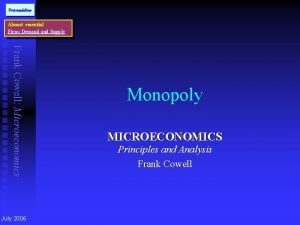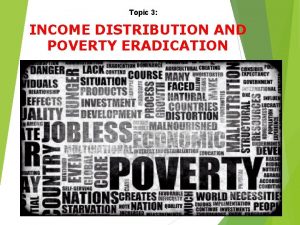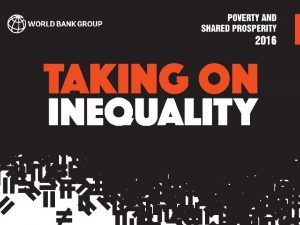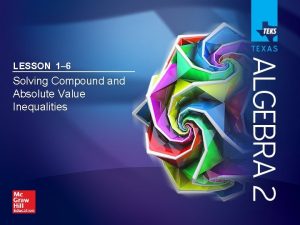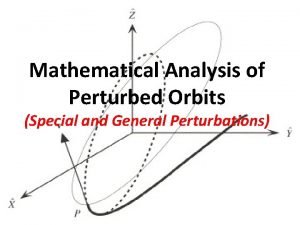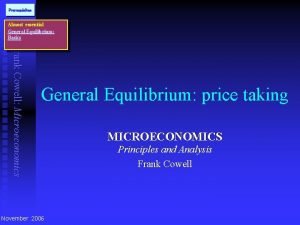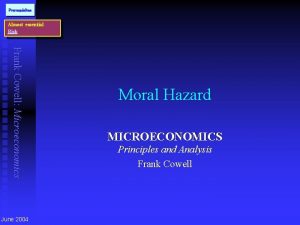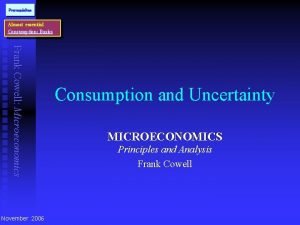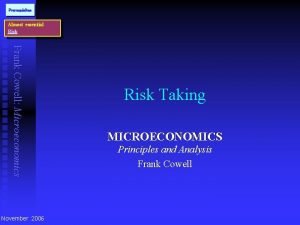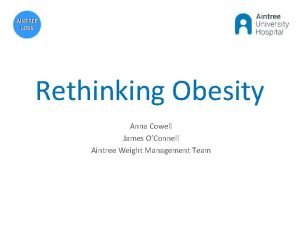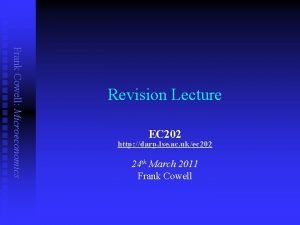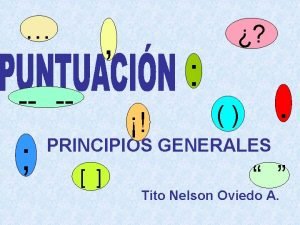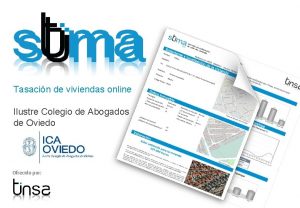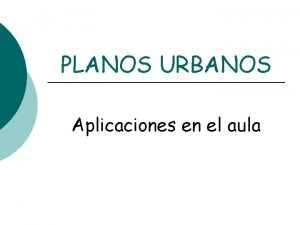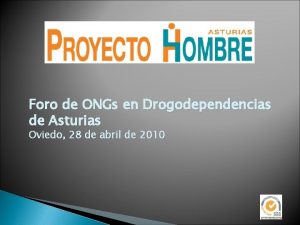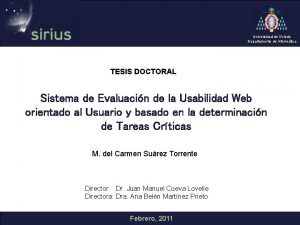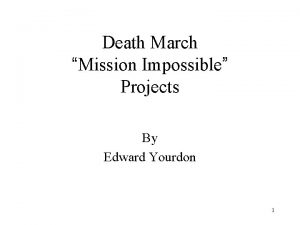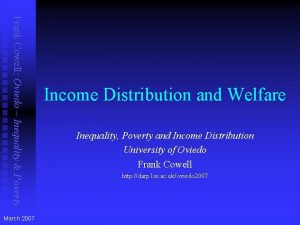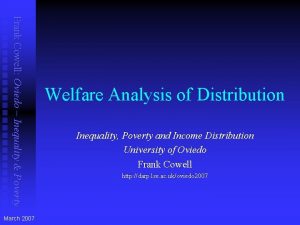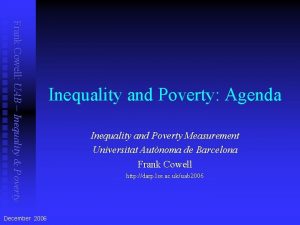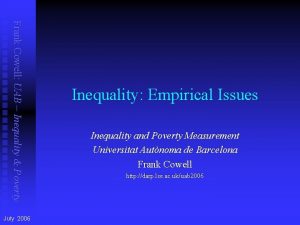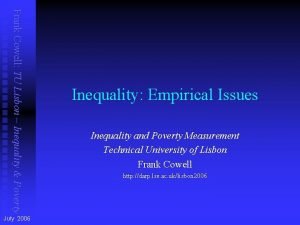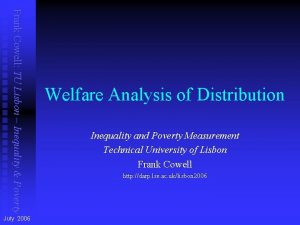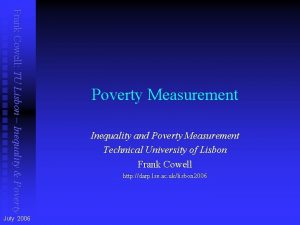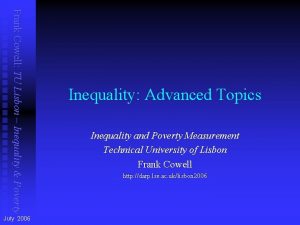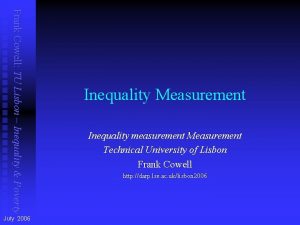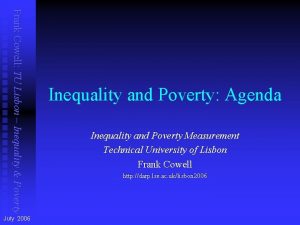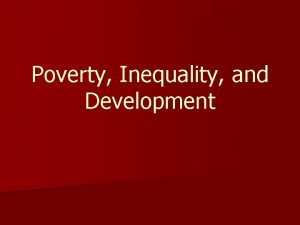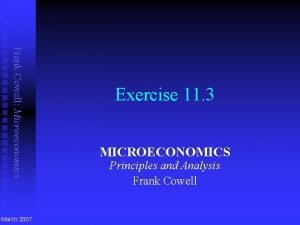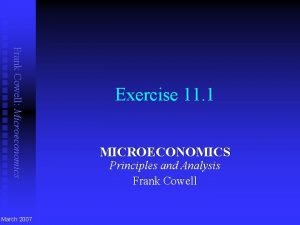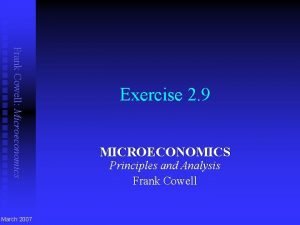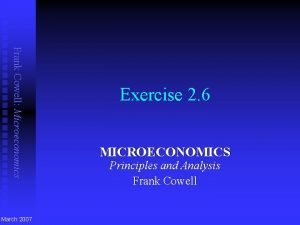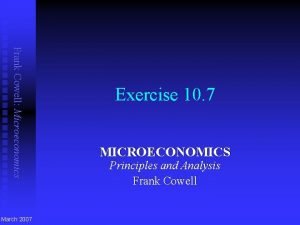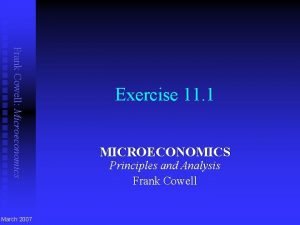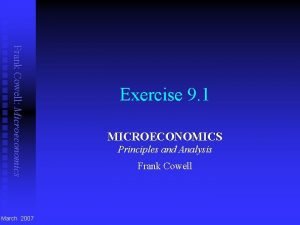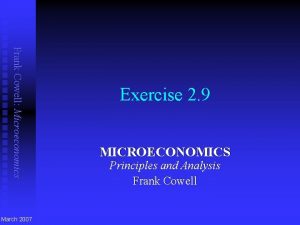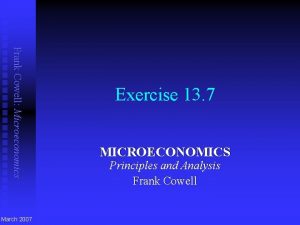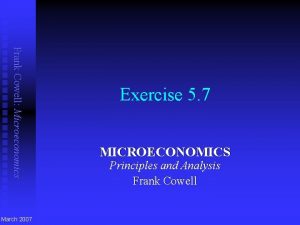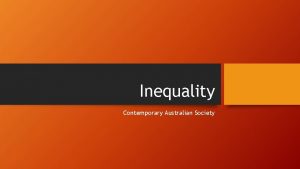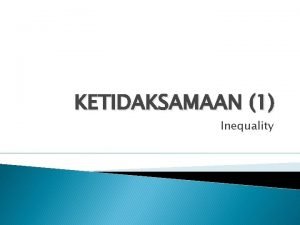Frank Cowell Oviedo Inequality Poverty March 2007 Poverty









































- Slides: 41

Frank Cowell: Oviedo – Inequality & Poverty March 2007 Poverty Measurement Inequality, Poverty and Income Distribution University of Oviedo Frank Cowell http: //darp. lse. ac. uk/oviedo 2007

Frank Cowell: Oviedo – Inequality & Poverty Issues to be addressed n Builds on Lectures 3 and 4 u u n Extension of ranking criteria u n Generalised Lorenz curve again Examine structure of poverty indices u n “Income Distribution and Welfare” “Inequality measurement” Link with inequality analysis Axiomatics of poverty

Frank Cowell: Oviedo – Inequality & Poverty Overview. . . Poverty measurement Poverty concepts …Identification and representation Poverty measures Empirical robustness Poverty rankings Conclusion

Frank Cowell: Oviedo – Inequality & Poverty analysis – overview n Basic ideas u n n Income – similar to inequality problem? t Consumption, expenditure or income? t Time period t Risk u Income receiver – as before u Relation to decomposition Development of specific measures u Relation to inequality u What axiomatisation? Use of ranking techniques u Relation to welfare rankings

Frank Cowell: Oviedo – Inequality & Poverty measurement n n How to break down the basic issues. Sen (1979): Two main types of issues u u n Jenkins and Lambert (1997): “ 3 Is” u u u n Identification problem Aggregation problem Incidence Intensity Inequality Present approach: u u u population Fundamental partition Individual identification Aggregation of information non-poor

Frank Cowell: Oviedo – Inequality & Poverty and partition n A link between this subject and inequality decomposition. u u n n Asymmetric treatment of information Exogeneity of partition? u n Partitioning of population is crucial Depends on definition of poverty line Does it depend on the distribution of income? Uniqueness of partition? u May need to deal with ambiguities in definition of poverty line

Frank Cowell: Oviedo – Inequality & Poverty Counting the poor n n Use the concept of individual poverty evaluation Simplest version is (0, 1) u u n (non-poor, poor) headcount Perhaps make it depend on income u poverty deficit n Or on the whole distribution? n Convenient to work with poverty gaps

poverty evaluation Frank Cowell: Oviedo – Inequality & Poverty The poverty line and poverty gaps gi 0 gj xi xj z x income

§ the “head-count” § the “poverty deficit” § sensitivity to inequality amongst the poor § Income equalisation amongst the poor poverty evaluation Poor Non-Poor x=0 Frank Cowell: Oviedo – Inequality & Poverty evaluation B A gj 0 gi g poverty gap

Frank Cowell: Oviedo – Inequality & Poverty Brazil 1985: How Much Poverty? § A highly skewed distribution § A “conservative” z § A “generous” z § An “intermediate” z § The censored income distribution Rural Belo Horizonte poverty line compromise poverty line Brasilia poverty line $0 $20 $40 $60 $80 $100 $120 $140 $160 $180 $200 $220 $240 $260 $280 $300

Frank Cowell: Oviedo – Inequality & Poverty The distribution of poverty gaps $0 $20 $40 $60 gaps

Frank Cowell: Oviedo – Inequality & Poverty Overview. . . Poverty measurement Poverty concepts Aggregation information about poverty Poverty measures Empirical robustness Poverty rankings Conclusion

Frank Cowell: Oviedo – Inequality & Poverty ASP n n n Additively Separable Poverty measures ASP approach simplifies poverty evaluation Depends on own income and the poverty line. u n n Assumes decomposability amongst the poor Overall poverty is an additively separable function u n p(x, z) P = p(x, z) d. F(x) Analogy with decomposable inequality measures

Frank Cowell: Oviedo – Inequality & Poverty A class of poverty indices n ASP leads to several classes of measures Make poverty evaluation depend on poverty gap Normalise by poverty line Foster-Greer-Thorbecke class n Important special case a = 0 n n n u u u n poverty evaluation is simple: {0, 1} gives poverty rate = poverty count / n Important special case a = 1 u u u poverty evaluation is simple: normalised poverty gap g/z gives poverty deficit measures resources needed to remove poverty

p(x, z) z-x Frank Cowell: Oviedo – Inequality & Poverty evaluation functions

Frank Cowell: Oviedo – Inequality & Poverty Other ASP measures n Other ASP indices focus directly on incomes rather than gaps Clark et al (1981) n where b < 1 is a sensitivity parameter Watts n u n Both can give rise to empirical problems Cowell. and Victoria-Feser, (1996)

Frank Cowell: Oviedo – Inequality & Poverty Quasi ASP measures n n Consider also quasi-ASP This allows ranks or position in the evaluation function u n Sen (1976) is the primary example u u n p(x, z, F(x) ) Based on an axiomatic approach incorporates, poverty count, poverty deficit, Gini amongst poor Poverty evaluation function:

Frank Cowell: Oviedo – Inequality & Poverty measures: assessment n ASP class is fruitful u u n n But which members of it are appropriate? Questionnaire experiments again? u u n neat and elegant interesting axiomatisation – see next lecture Amiel-Cowell (1999) Many of Sen (1976) axioms rejected In particular transfer principle rejected which also rules out FGT measures for a > 1 Leading poverty measures are still u u Poverty count or ratio Poverty deficit

Frank Cowell: Oviedo – Inequality & Poverty Overview. . . Poverty measurement Poverty concepts Definitions and consequences Poverty measures Empirical robustness Poverty rankings Conclusion

Frank Cowell: Oviedo – Inequality & Poverty Empirical robustness n n Does it matter which poverty criterion you use? Look at two key measures from the ASP class u u n Use two standard poverty lines u u n n n Head-count ratio Poverty deficit (or average poverty gap) $1. 08 per day at 1993 PPP $2. 15 per day at 1993 PPP How do different regions of the world compare? What’s been happening over time? Use World-Bank analysis u Chen-Ravallion “How have the world’s poorest fared since the early 1980 s? ” World Bank Policy Research Working Paper Series 3341

Frank Cowell: Oviedo – Inequality & Poverty rates by region 1981

Frank Cowell: Oviedo – Inequality & Poverty rates by region 2001

Frank Cowell: Oviedo – Inequality & Poverty: East Asia

Frank Cowell: Oviedo – Inequality & Poverty: South Asia

Frank Cowell: Oviedo – Inequality & Poverty: Latin America, Caribbean

Frank Cowell: Oviedo – Inequality & Poverty: Middle East and N. Africa

Frank Cowell: Oviedo – Inequality & Poverty: Sub-Saharan Africa

Frank Cowell: Oviedo – Inequality & Poverty: Eastern Europe and Central Asia

Frank Cowell: Oviedo – Inequality & Poverty Empirical robustness (2) n n n Does it matter which poverty criterion you use? An example from Spain u Bárcena and Cowell (2006) Data are from ECHP OECD equivalence scale Poverty line is 60% of 1993 median income Does it matter which FGT index you use?

Frank Cowell: Oviedo – Inequality & Poverty in Spain 1993— 2000

Frank Cowell: Oviedo – Inequality & Poverty Overview. . . Poverty measurement Poverty concepts Another look at ranking issues Poverty measures Empirical robustness Poverty rankings Conclusion

Frank Cowell: Oviedo – Inequality & Poverty Extension of poverty analysis n n Now consider some further generalisations What if we do not know the poverty line? Can we find a counterpart to second order dominance in welfare analysis? What if we try to construct poverty indices from first principles?

Frank Cowell: Oviedo – Inequality & Poverty rankings (1) n n n Atkinson (1987) connects poverty and welfare. Based results on the portfolio literature concerning “belowtarget returns” Theorem u u u n Given a bounded range of poverty lines (zmin, zmax) and poverty measures of the ASP form a necessary and sufficient condition for poverty to be lower in distribution F than in distribution G is that the poverty deficit be no greater in F than in G for all z ≤ zmax. Equivalent to requiring that the second-order dominance condition hold for all z.

Frank Cowell: Oviedo – Inequality & Poverty rankings (2) n n n Foster and Shorrocks (1988 a, 1988 b) have a similar approach to orderings by P, But concentrate on the FGT index’s particular functional form: Theorem: Poverty rankings are equivalent to u u u first-order welfare dominance for a = 0 second-degree welfare dominance for a = 1 (third-order welfare dominance for a = 2. )

Frank Cowell: Oviedo – Inequality & Poverty concepts – more n Given poverty line z u n Poverty gap u n fundamental income difference Define the number of the poor as: u n a reference point p(x, z) : = #{i: xi ≤ z} Cumulative poverty gap

Frank Cowell: Oviedo – Inequality & Poverty TIP / Poverty profile • Cumulative gaps versus population proportions • Proportion of poor • TIP curve G(x, z) § TIP curves have same interpretation as GLC §TIP dominance implies unambiguously greater poverty 0 i/n p(x, z)/n

Frank Cowell: Oviedo – Inequality & Poverty Overview. . . Poverty measurement Poverty concepts Building from first principles? Poverty measures Empirical robustness Poverty rankings Conclusion

Frank Cowell: Oviedo – Inequality & Poverty Brief conclusion n Framework of distributional analysis covers a number of related problems: u u u n n Commonality of approach can yield important insights Ranking principles provide basis for broad judgments u u n Social Welfare Inequality Poverty May be indecisive specific indices could be used Poverty trends will often be robust to choice of poverty index

Frank Cowell: Oviedo – Inequality & Poverty: a way forward n Introduce a formal axiomatisation of ASP class? u u n Use standard axioms introduced earlier u u n for analysing social welfare for inequality Show this is related to u u n In particular FGT measures See Ebert and Moyes (2002) deprivation inequality See next lecture

Frank Cowell: Oviedo – Inequality & Poverty References (1) n n n n Amiel, Y. and Cowell, F. A. (1999) Thinking about Inequality, Cambridge University Press Atkinson, A. B. (1987) “On the measurement of poverty, ” Econometrica, 55, 749 -764 Bárcena, E. and Cowell, F. A. (2006) “Static and Dynamic Poverty in Spain, 1993 -2000, ” Hacienda Pública Española 179 Chen, S. and Ravallion, M. (2004) “How have the world’s poorest fared since the early 1980 s? ” World Bank Policy Research Working Paper Series, 3341 Clark, S. , Hemming, R. and Ulph, D. (1981) “On indices for the measurement of poverty, The Economic Journal, 91, 515 -526 Cowell, F. A. and Victoria-Feser, M. -P. (1996) “Poverty Measurement with Contaminated Data: A Robust Approach, ” European Economic Review, 40, 1761 -1771 Ebert, U. and P. Moyes (2002) “A simple axiomatization of the Foster. Greer-Thorbecke poverty orderings, ” Journal of Public Economic Theory 4, 455 -473. Foster, J. E. , Greer, J. and Thorbecke, E. (1984) “A class of decomposable poverty measures, ” Econometrica, 52, 761 -776

Frank Cowell: Oviedo – Inequality & Poverty References (2) n n n n Foster , J. E. and Shorrocks, A. F. (1988 a) “Poverty orderings, ” Econometrica, 56, 173 -177 Foster , J. E. and Shorrocks, A. F. (1988 b) “Poverty orderings and welfare dominance, ” Social Choice and Welfare, 5, 179 -198 Jenkins, S. P. and Lambert, P. J. (1997) “Three ‘I’s of poverty curves, with an analysis of UK poverty trends, ” Oxford Economic Papers, 49, 317 -327. Sen, A. K. (1976) “Poverty: An ordinal approach to measurement, ” Econometrica, 44, 219 -231 Sen, A. K. (1979) “Issues in the measurement of poverty, ” Scandinavian Journal of Economics, 91, 285 -307 Watts, H. W. (1968) “An economic definition of poverty, ” in Moynihan, D. P. (ed) Understanding Poverty, Basic Books, New York, Chapter, 11, 316 -329 Zheng, B. (1993) “An axiomatic characterization of the Watts index, ” Economics Letters, 42, 81 -86 Zheng, B. (2000) “Minimum Distribution-Sensitivity, Poverty Aversion, and Poverty Orderings, ” Journal of Economic Theory, 95, 116 -137
 Frank cowell
Frank cowell Frank cowell microeconomics solutions
Frank cowell microeconomics solutions Almost essential
Almost essential New bill
New bill Frank cowell
Frank cowell Poland national anthem lyrics
Poland national anthem lyrics Absolute poverty and relative poverty
Absolute poverty and relative poverty Inequality and poverty
Inequality and poverty Lesson 1-6 compound inequalities
Lesson 1-6 compound inequalities Cowell's method
Cowell's method Almost essential
Almost essential Cowell microeconomics
Cowell microeconomics Cowell china
Cowell china Cowell microeconomics
Cowell microeconomics Cowell microeconomics
Cowell microeconomics Agilent erp
Agilent erp Aintree loss criteria
Aintree loss criteria Cowell microeconomics
Cowell microeconomics Santo angel oviedo
Santo angel oviedo Oviedo convention
Oviedo convention Nelson oviedo
Nelson oviedo Hotel vetusta oviedo
Hotel vetusta oviedo 913727500
913727500 Tipos planos urbanos
Tipos planos urbanos Utt oviedo
Utt oviedo Corporate compliance oviedo
Corporate compliance oviedo Etika u dentalnoj medicini
Etika u dentalnoj medicini Oviedo
Oviedo Colegio las dominicas oviedo
Colegio las dominicas oviedo Frank william abagnale jr
Frank william abagnale jr Deficiency of
Deficiency of French revolution women's march
French revolution women's march Geogrphic
Geogrphic American idol
American idol Macro march
Macro march March 2 success.com
March 2 success.com Genetic engineering conclusion
Genetic engineering conclusion Welcome to our english class
Welcome to our english class Happy wednesday march
Happy wednesday march Summer winter fall spring months
Summer winter fall spring months Critical essay structure
Critical essay structure Death march edward yourdon
Death march edward yourdon
